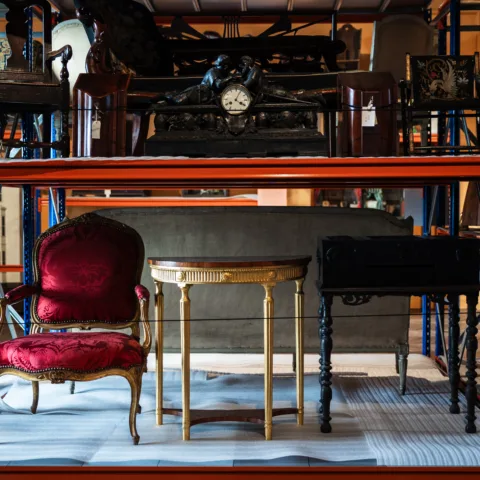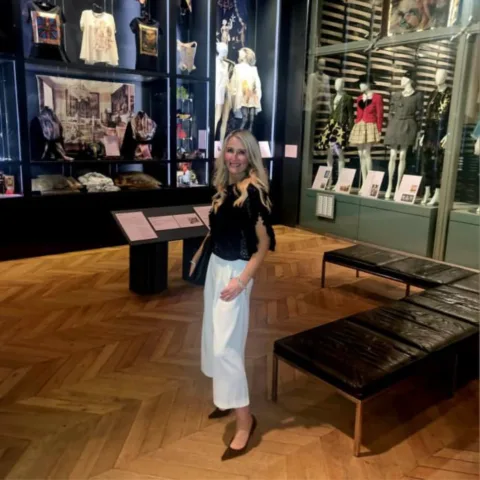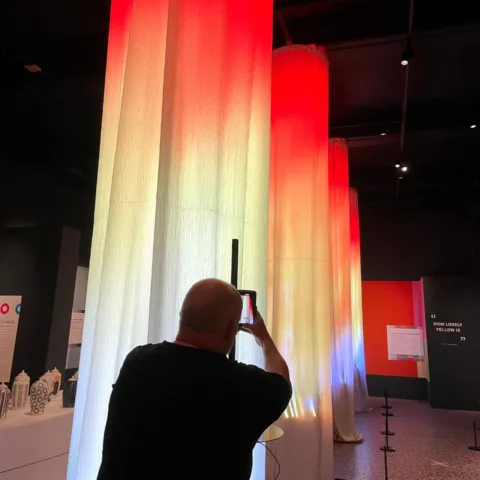The Bowes Museum Blog

Quilts from A to V (that’s Assessment to Velcro!)
To coincide with our upcoming exhibition Quiltscapes & Quiltline by contemporary quiltmaker Pauline Burbidge, I am currently assessing and preparing a selection of historic quilts from our own collection. These will be hung in the Glass Cube area of the Fashion & Textile Gallery, on our hanging bar system – allowing each to be brought down individually for closer study.
We have a large number of quilts and quilted textiles in our collection, and several waiting to be catalogued (incuding some exciting new acquisitions, which I will tell you about in a later blog post). These include examples from the late 17th century onwards, pieced and wholecloth; bedspreads, cot covers, and other quilted items including petticoats and pillowcases.
The last major exhibition of quilts at the Museum was in the year 2000, entitled ‘North Country Quilts’, with an accompanying publication. For this new temporary display, the Assistant Curator, Hannah, is mostly selecting quilts acquired since 2000, some of which have not been shown before. From her long-list of desirable quilts, I have been carrying out assessments, determining the suitability of each for display, and adding up the number of hours work each will take to prepare.
With each quilt unrolled for assessment, it is a good opportunity to take some more detailed photographs, check that we have the correct description and dimensions, remove any old Velcro, replace the stitched-in object labels where necessary, and finally, re-roll the quilts using archival materials. We store all of our quilts rolled, which prevents any creases forming, on cardboard or plastic rollers. They are all rolled widthways (the narrowest part), so that they take up less space in the stores. Current storage conditions are not ideal. We are aiming to have every quilt on a roller approximately 6-8 inches in diameter, and 6 inches longer than the quilt at each end for handling. The quilts are split between five stores, all of which are on the 3rd and 4th floors of the Museum, either way, it’s a lot of fetching and carrying to get them into the studio and back.![Two cot quilts, rolled alongside one another on a narrow roller (before re-rolling) [Quilt.29 A + B]](https://thebowesmuseum.files.wordpress.com/2015/09/dsc03855.jpg?w=300)
Two cot quilts, face down, these had been rolled alongside one another on a narrow roller (before re-rolling) [Quilt.29 A + B]
As each quilt has been re-rolled, it has been interleaved with acid-free tissue paper, and wrapped in a final layer of Tyvec, a synthetic fabric more commonly used in the housebuilding industry, but favoured in museums as it is lightweight, breathable, but waterproof. Tyvek acts as a barrier to dust, dirt, pests (although they will eat through it if they are determined to get at the contents) and water (in case of leaks/floods). Each roll has been secured with lengths of Velcro, and the rollers returned to the stores, propped up off the floor, and away from each other. Labelling each quilt clearly allows them to be found quickly, and the location of each is recorded on our museum database, Adlib.

Quilts re-rolled and returned to store, using wooden or metal poles to suspend them in our homemade wooden box system. New object labels with photographs make them easier to identify
In the past few weeks, Hannah and I have looked at, and re-rolled 34 quilts, that’s 152 square metres’ worth, and used more than 275m of acid-free tissue. We now have our (almost) final object list, and I can programme the work in, to get each quilt ready to install by the time the new exhibition opens on November 28th. I’ve found some beautiful quilts, with incredible stories, which I’ll blog about over the new few weeks. We are only half-way through re-rolling the entire collection, so there is more work to be done at a later date.

Re-rolling Quilt.1.14 – an unfinished quilt top, made of silk fabrics, with the original papers visible on the reverse
Katy Smith, Textile Conservator



![Detail of quilt, showing condition of applique [Quilt.18]](https://thebowesmuseum.files.wordpress.com/2015/09/dsc03703.jpg?w=300)










